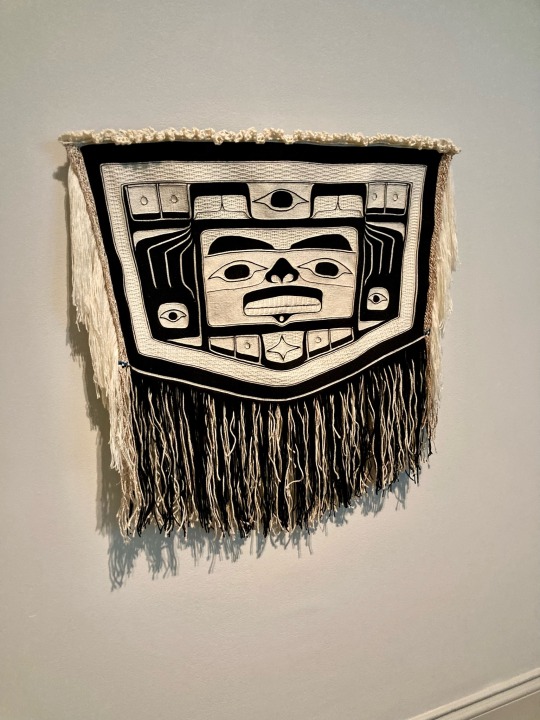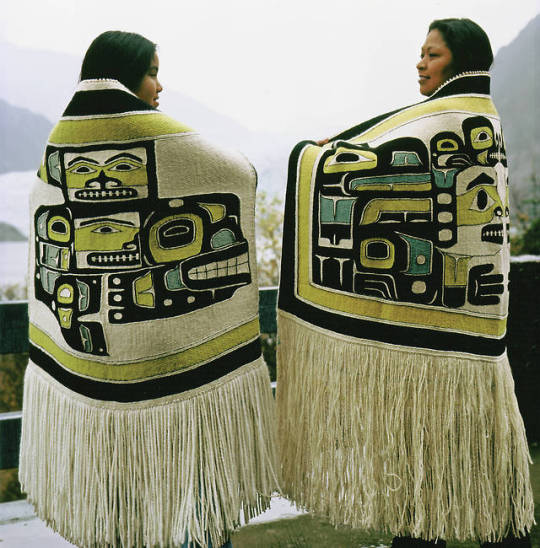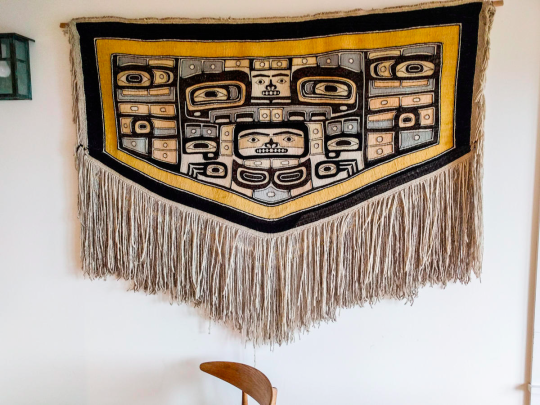#chilkat art
Explore tagged Tumblr posts
Text



Believe it or not, today was my first visit to the Burke Museum ever! After my post the other day marveling that it had been two months since I went to Bend, and realizing I haven't really gone anywhere since, I decided to sneak up to Seattle for an overnight so I could spend today immersed in exhibits.
I'm honestly feeling overwhelmed in a good way; there's just so much... everything there! I will definitely be going back multiple times in the future, but for now I'm just digesting what I saw today.
#museum#Burke Museum#Seattle#Washington#PNW#fossils#paleontology#mammals#Pleistocene#birds#art#Chilkat weaving#Northwest Coast#indigenous art#native art#Tlingit
44 notes
·
View notes
Text
#WorldOrcaDay:

Chilkat blanket with Orca design, Tsimshian (Pacific NW Coast)
Twined weave; warp of yellow cedar bark & mountain goats' wool, weft of pure mountain goats' wool
Field Museum no. 19571 (photographed on display in 2022)
#animals in art#animal holiday#museum visit#Field Museum#World Orca Day#orca#orcas#killer whale#killer whales#whale#whales#cetaceans#sea mammals#Pacific Northwest Coast art#Chilkat#Tsimshian#First Nations art#Native American art#Indigenous art#textiles#wool#blanket
75 notes
·
View notes
Text

#Chilkat weaving#Sister Bear#Ursula Hudson#art#Tlingit#Native America#Renwick Gallery#Smithsonian#Washington DC
4 notes
·
View notes
Photo
More info on Anna Brown Ehlers (whose amazing work continues), Jennie Thlunaut (who did this art for 75 years) and their work—and on this Japanese program (via web archive).

Anna Brown Ehlers (right) and her art, made using Chilkat weaving techniques. Ehlers is Tlingit, born and raised in Juneau
h/t twitter.com/womensart1
19K notes
·
View notes
Text

(Cowichan elder Dora Wilson)
Since it's definitely sweater season, I felt like doing a deep dive into a really unique and interesting bit of knitting history: the Cowichan sweater, sometimes also called the Canadian sweater.
Spinning and weaving among tribes in the Pacific Northwest is something that goes back to pre-colonial times, using wool from domestic dogs and wild mountain goats.

(photo of the now-extinct breed, the Salish Wool Dog)
The wool was then woven into stunningly warm garments and blankets, like the famous chilkat blanket.

(Chilkat Blanket, Saint Louis Art Museum)
With colonization brought the introduction of domestic sheep, which could be reliably herded and used for wool.
It's not entirely clear who introduced knitting to the Cowichan tribe, but it's clear by the early 20th century, an industry had grown up around selling hand-knit sweaters with traditional Native design motifs on them.


455 notes
·
View notes
Text

Blue and Red (Where Little Bear Learned to Hide from the Sun)
Ursala Hudson
from the website: “My mother was a Chilkat ceremonial regalia maker, and now I am one too. Weaving regalia for ceremony can be a heavy responsibility, as a finished robe embodies generations of ancestral knowledge and hundreds of hours of technical labor. At the same time, it is a great honor to be the instrument through which our ancestors speak their stories and dreams.
One of the most influential mentors in my life has been Cecil Touchon, who is a non-Indigenous American contemporary artist and theorist. Cecil was a close friend of my family and spent many studio hours training us in the art of collage. He encouraged us to collage on watercolor paper with large blank margins on all sides, and to work intuitively, simply, and quickly. Collage work became a fun family pasttime growing up, and allowed us a regular practice in traversing the present moment, outside of ancestral tradition or the weight of preparing for ceremony. It was another way to bring together my family of mixed heritage and culture.
In Blue and Red, I use my primary art medium of Chilkat and Ravenstail weaving of my Tlingit homelands to depict an abstract contemporary “collage” on woven “watercolor paper” with large margins and my signature “signed” on the bottom edge. Instead of three hours of cutting and pasting, this weaving took over 50 hours from start to finish. I honor my greatest influences, from both within and without my Indigenous heritage, respecting the profoundly valuable lessons they both have offered me. “Blue and Red” tells a story about the contemporary Indigenous present.”
– Ursala Hudson
116 notes
·
View notes
Note
if this is a weird question feel free to ignore but from the design of sokka you made for the chilling in a pond art. is the vest thingie he's wearing a cultural reference to anything or is it just fun character design? it looks really cool so i got curious
there are no weird questions. feel free to ask! thank you
it is mostly a fun character design. as much i like to designs as closley as possible to the original sources and cultural insipirations they had for the show sometimes you just end up making something up when i try to also keep canon a bit in mind.
i know that sokka canonicaly doesn't wear a vest or anything even similar to a vest, but i am alergic to just putting him in a sleaveless wrap shirt and slap some fur on it and call it a day.
nether the less i think my brain does end mixing things toghether that give sort of some vibes back from things i have learned or seen before. we all know and agree that southern water tripe is based an circumpolar people cultures.
i think the fringe are somethin i picked up form parka the singer Shina Novalinga wears in her videos sometimes.
an other source could be Tlingit. their name poppud up a lot when i was researching lamellar armor. they wear this amazing Chilkat blankets with these large fringes. (they are more north west east cost. but they have teritory in alaska and canada) and also... i just like to add shells because... well live near by the ocean, fishing and such.... i like to think they decorate clothing with it because these things are around. also the moon stiching is a giving. i don't think sokka can ever let go of his first love yue
#chip!ask#honestly one day i will figure out something for sokka to wear in milder climates that is perhaps more accurate#but till that day comes i have to dress him in something!!!
23 notes
·
View notes
Link
This piece is on display at the Burke Museum of Natural History and Culture in Seattle. I went there for my birthday and they have great exhibits of indigenous art (and food at the cafe). Seeing the weaving displays, I remembered this story and was telling it to my friends and then we rounded corner and there it was!
Sara Jacobsen, 19, grew up eating family dinners beneath a stunning Native American robe.
Not that she gave it much thought. Until, that is, her senior year of high school, when she saw a picture of a strikingly similar robe in an art history class.
The teacher told the class about how the robe was used in spiritual ceremonies, Sara Jacobsen said. “I started to wonder why we have it in our house when we’re not Native American.”
She said she asked her dad a few questions about this robe. Her dad, Bruce Jacobsen, called that an understatement.
“I felt like I was on the wrong side of a protest rally, with terms like ‘cultural appropriation’ and ‘sacred ceremonial robes’ and ‘completely inappropriate,’ and terms like that,” he said.
“I got defensive at first, of course,” he said. “I was like, ‘C’mon, Sara! This is more of the political stuff you all say these days.’”
But Sara didn’t back down. “I feel like in our country there are so many things that white people have taken that are not theirs, and I didn’t want to continue that pattern in our family,” she said.
The robe had been a centerpiece in the Jacobsen home. Bruce Jacobsen bought it from a gallery in Pioneer Square in 1986, when he first moved to Seattle. He had wanted to find a piece of Native art to express his appreciation of the region.

The Chilkat robe that hung over the Jacobsen dining room table for years. Credit Courtesy of the Jacobsens
“I just thought it was so beautiful, and it was like nothing I had seen before,” Jacobsen said.
The robe was a Chilkat robe, or blanket, as it’s also known. They are woven by the Tlingit, Haida and Tsimshian peoples of Alaska and British Columbia and are traditionally made from mountain goat wool. The tribal or clan origin of this particular 6-foot-long piece was unclear, but it dated back to around 1900 and was beautifully preserved down to its long fringe.
“It’s a completely symmetric pattern of geometric shapes, and also shapes that come from the culture,” like birds, Jacobsen said. “And then it’s just perfectly made — you can see no seams in it at all.”
Jacobsen hung the robe on his dining room wall.
After more needling from Sara, Jacobsen decided to investigate her claims. He emailed experts at the Burke Museum, which has a huge collection of Native American art and artifacts.
“I got this eloquent email back that said, ‘We’re not gonna tell you what to go do,’ but then they confirmed what Sara said: It was an important ceremonial piece, that it was usually owned by an entire clan, that it would be passed down generation to generation, and that it had a ton of cultural significance to them.“
Jacobsen says he was a bit disappointed to learn that his daughter was right about his beloved Chilkat robe. But he and his wife Gretchen now no longer thought of the robe as theirs. Bruce Jacobsen asked the curators at the Burke Museum for suggestions of institutions that would do the Chilkat robe justice. They told him about the Sealaska Heritage Institute in Juneau.
When Jacobsen emailed, SHI Executive Director Rosita Worl couldn’t believe the offer. “I was stunned. I was shocked. I was in awe. And I was so grateful to the Jacobsen family.”
Worl said the robe has a huge monetary value. But that’s not why it’s precious to local tribes.
“It’s what we call ‘atoow’: a sacred clan object,” she said. “Our beliefs are that it is imbued with the spirit of not only the craft itself, but also of our ancestors. We use [Chilkat robes] in our ceremonies when we are paying respect to our elders. And also it unites us as a people.”
Since the Jacobsens returned the robe to the institute, Worl said, master weavers have been examining it and marveling at the handiwork. Chilkat robes can take a year to make – and hardly anyone still weaves them.
“Our master artist, Delores Churchill, said it was absolutely a spectacular robe. The circles were absolutely perfect. So it does have that importance to us that it could also be used by our younger weavers to study the art form itself.”
Worl said private collectors hardly ever return anything to her organization. The federal Native American Graves Protection and Repatriation Act requires museums and other institutions that receive federal funding to repatriate significant cultural relics to Native tribes. But no such law exists for private collectors.

Bruce and Gretchen Jacobsen hold the Chilkat robe they donated to the Sealaska Heritage Institute as Joe Zuboff, Deisheetaan, sings and drums and Brian Katzeek (behind robe) dances during the robe’s homecoming ceremony Saturday, August 26, 2017. Credit NOBU KOCH / SEALASKA HERITAGE INSTITUTE
Worl says the institute is lobbying Congress to improve the chances of getting more artifacts repatriated. “We are working on a better tax credit system that would benefit collectors so that they could be compensated,” she said.
Worl hopes stories like this will encourage people to look differently at the Native art and artifacts they possess.
The Sealaska Heritage Institute welcomed home the Chilkat robe in a two-hour ceremony over the weekend. Bruce and Gretchen Jacobsen traveled to Juneau to celebrate the robe’s homecoming.
89K notes
·
View notes
Text

#Haida society continues to produce a robust and highly stylized art form, a leading component of Northwest Coast art. While artists frequently have expressed this in large wooden carvings (totem poles), Chilkat r expression such as Haida manga.
2 notes
·
View notes
Text








Why does Indigenous artwork go so hard though?
I swear the tribes of the Pacific Northwest are on the next level when it comes to making something beautiful. Chilkat blankets???? Formline design??? Transformation masks????? they are so incredible it's unbelievable. Picasso can lick the shoes of these people. I had no idea that formline design basically invented visual punning. The use of negative space is out of this world It's amazing how they can keep tradition alive whilst still keeping such an ancient within the present. I love how all the Chilkat robes look SIMILAR but not the SAME. The same style has been passed down generations and through the Indian act and is still being made today!!
How cool is it that people from Tlinkit, Kwakwaka'awkw and Haida tribes can look at a Chilkat robe and literally see their family history spelled out before them in art. 🤩🤩
Now THAT'S heritage!
Go check out Lily Hope she is such a skilled weaver:


4 notes
·
View notes
Text

Chilkat shirt (late 1800s) Dyed mountain goat wool and cedar bark
Currently held by the Denver Art Museum
#history#world history#art history#indigenous history#indigenous art#native american history#native american art#tlingit art#chilkat art#textile#textile art#textile history#denver art museum#19th century
56 notes
·
View notes
Text
Yes, absolutely!
And I will write up all my overexcited thoughts on creating drafts and designs, at some future point when I have the time and sanity.
Of course, there’s plenty of books on this subject already, so you don’t need to listen to me. I just have a somewhat different approach than the books I’ve read, and am itching to share.
A lot of tapestries are actually just plain weave in structure. Your floor loom can be used for that kind of tapestry, but also more structurally complex things like figured brocade, shadow weave, summer and winter, rose path, etc etc.
A book you might find useful is “Weft-Faced Pattern Weaves: Tabby to Taqueté” by Nancy Arthur Hoskins.
(To sidetrack, the pinnacle of tapestry art is Chilkat weaving/twining. It can NOT be woven on a floor loom. It uses completely different, absolutely brilliant techniques. I highly recommend “The Chilkat Dancing Blanket” by Cheryl Samuel. More people ought to know and honor Jennie Thlunaut’s name.)
Sidetracking even more completely, “false ikat”, the type using deliberate color-pooling or patterned sock yarn, is a ton of fun, and can be used as a background for other techniques (like brocade):
Probably very obvious but if I were to follow this draft to make my kitchen towels:

And I used all black for my weft, which parts of this design would turn out black, the white or the peachy-orange?
33 notes
·
View notes
Photo

Mary Willard (Klukwan), Chilkat Blanketry, 5-3-46. -- Alaska State Library-Historical Collections.
9 notes
·
View notes
Photo

ABAYA'A SARAH MARTIN (D. 1963) Chilkat blanket c.1950-53
Wool | 205.0 x 123.0 cm (whole object) | RCIN 33026
16 notes
·
View notes
Photo

Plate 3. "The Whale House of the Chilkat,” interior entrance posts. Anthropological papers of the American Museum of Natural History. v.XIX, pt. 1. 1916.
#carving#architecture#native american art#tlingit#chilkat people#ritual art#domestic architecture#nemfrog#1916#1910s
301 notes
·
View notes
Text

dress by Mrs. Walking Sun, Nadoka (Assiniboine), 1941, The Royal Ontario Museum

Chief American Horse's Outfit, 1900-1913, The McCord Museum

Chilkat robe, Tlingit, 1860, The Fenimore Art Museum


Inuit Girls

Three Blackfeet Chiefs

Wet'suwet'en hereditary chiefs protesting

Cree women in powwow regalia

White men in Canadian Tuxedos
youtube
186 notes
·
View notes